Research Article | Open Access
Measurement of Microvessel Density Using CD105 (Endoglin) as a Marker in Prostatic Adenocarcinoma
Sheenam Azad1, Garima Sharma1 , Monika Kochhar1, Saqib Ahmed1, Seema Acharya1, Sadaf Khan1
1Department
of Pathology, Shri Guru Ram Rai Institute of Medical & Health Sciences,
Dehradun, Uttarakhand, India.
Correspondence: Saqib Ahmed (Department of Pathology, Shri Guru Ram Rai Institute Of Medical and Health Sciences, 4/1653/1 beside Dr Anejas Hospital, Link Road, Saharanpur, Uttar Pradesh, 247001, India; Email: saqibahmed.mail@gmail.com).
Annals of Urologic Oncology 2023, 6(4): 161-166. https://doi.org/10.32948/auo.2023.12.31
Received: 10 Dec 2023 | Accepted: 31 Dec 2023 | Published online: 31 Dec 2023
Introduction Angiogenesis has been proposed as a promising prognostic marker in a variety of tumours. Microvessel density (MVD) measurement is the most reliable method for the semiquantitative evaluation of angiogenesis. Endoglin (CD105) is a recognised marker of proliferating endothelium and is expressed in intra-tumoral as well as peri-tumoral vessels. It is upregulated in various cancers including prostate cancer, therefore, it is an upcoming prime marker for prognosis, tumour imaging and antiangiogenesis therapy.
Aim The study was done to evaluate microvessel density (MVD) by using CD105 (endoglin) as an IHC marker in prostatic adenocarcinoma and to find its relationship with Gleason score and grade groups.
Materials and methods This was an observational cross-sectional study under which a total of 31 histopathologically diagnosed cases of prostatic adenocarcinoma on TURP chips were included and were graded according to Gleason score and grades.IHC using endoglin (CD105) was done to detect the highest-density areas of stained vessels (hot spots). The highest value obtained in three hot spot fields was reported as microvessel density (MVD) and its relationship with Gleason score and grade groups was analysed.
Results Most common age group was 71-80 years (48.39% cases). Maximum cases (45.16%) had a Gleason score of 9. The maximum mean MVD CD105 score was found in the Gleason grade group 5 (45.32%) while the minimum was in grade group 1 (24%). Comparison of mean MVD CD105 scores in different Gleason grade groups revealed a significant association of MVD CD105 with Gleason grade groups.
Conclusion Endoglin measures microvessel density and its expression correlated with Gleason score and grade group. Hence it can be used as a potential prognostic marker in adenocarcinoma prostate.
Keywords prostatic adenocarcinoma, angiogenesis, CD105, Gleason grade, microvessel density
Carcinoma
of the prostate is one of the most common malignancies amongst men worldwide
and is responsible for 10% of cancer deaths [1]. Globally
prostate cancer is the second most frequent malignancy (after lung cancer)
while in India it is the sixth most
common cancer with an age-adjusted incidence rate of 10.2/100,000 and
age-adjusted mortality rate of 4.2/100,000 population [2-4]. Many genetic and molecular
alterations have been observed in prostatic carcinoma including angiogenesis
which is important for tumour growth, progression and metastasis [5]. Parameters like the clinical stage, serum level of
prostate-specific antigen (PSA) and histological differentiation, reported as
the Gleason score
help in stratifying patients for
further likelihood of progression and type of therapy required. However, in
patients with an intermediate Gleason score (GS 6 and GS 7), accurate
prediction of outcome is often difficult. Therefore, there is a need for
biomarkers which can predict the clinical behaviour and course of prostatic
carcinoma [6]. Angiogenesis has been proposed as a
promising prognostic marker in a variety of tumours. The counting of
microvessel density (MVD) is one of the most representative methods to quantify
angiogenesis in human cancer tissues histologically
by observing the IHC expression of various endothelial markers like CD34,
CD31, and CD105 (endoglin). Endoglin is a transmembrane
glycoprotein which is upregulated in several cancers including prostatic
cancer. It is highly expressed in activated vascular endothelial cells but
weakly or not at all expressed in normal quiescent vessels. Endoglin is a marker of proliferating endothelium which is expressed in
intratumoral and peritumoral vessels. Because of these features, it is upcoming
as a prime marker for prognosis, tumour imaging and antiangiogenesis therapy [7]. Presently there are only limited studies
on the clinical significance and pathological roles of MVD measured by
CD105-positive vessels in prostate cancer tissues. Most of them have identified CD 105 as a significant and independent predictor
of progression and marker of recurrence in prostate cancer patients as well as
in various other malignancies including breast, rectal and hepatocellular
carcinomas [8-13]. This study was conducted to measure
and evaluate microvessel density using CD105 (endoglin) as a marker for
angiogenesis in prostatic adenocarcinoma and to determine its relationship with
Gleason score and grade groups. The current emphasizes the angiogenic role of endoglin (CD105) in
adenocarcinoma prostate signifying its role as a prognostic marker.
This study was an observational prospective study conducted in the Department of Pathology over nineteen months after getting approval from the institutional ethical committee. A total of thirty-one cases of transurethral resection of the prostate (TURP) chips were included. All inadequate biopsies and cases with marked inflammation obscuring the epithelium were excluded. Needle core biopsies were also excluded due to limited tissue. There were no prostatectomy cases received during the study period. The tissue received in histopathology in neutral buffered was grossed as per the standard protocol of the histopathology section. The tissues were processed in an automated tissue processor. These were paraffin-embedded, sectioned and stained with Hematoxylin -Eosin stained sections followed by light microscopic examination. The adenocarcinoma cases were graded and categorized using Gleason's scoring system [14-15]. One section each from a representative block was subjected to IHC marker endoglin (CD105). Representative sections of 2-3 microns were cut and taken on poly-1-lysine-coated slides. Brown-stained positive endothelial cell or endothelial cell cluster with or without lumen was considered as a single, countable microvessel. Slides were examined at low power magnification to find high-density areas of stained vessels (hot spots). The number of microvessels was then counted in high power in three such hot spots. The highest value obtained amongst the three fields was reported as microvessel density (MVD). All data were statistically analysed using SPSS 22.0 software. The difference between the two groups was determined using a t-test and the level of significance was at p<0.005.
The study included 31 cases of adenocarcinoma prostate. Maximum subjects were in the age group of 71-80 years (48.39%) followed by the age group of 61-70 years (29.03%). The least cases were in the age group 51-60 years (3.23%). The age range of subjects was from 52 to 93 years and the mean age was 74.58±7.82 years.
Gleasons scoring
Maximum cases had a Gleason score of 9 (14/31; 45.16%) followed by a Gleason score of 7 amongst which 3+4=7 (5/31; 16.1%) were more common than 4+3=7 (2/31; 6.5%). Four cases showed the highest Gleason score of 10 (4/31; 12.90%). Maximum cases (18/31; 58.0%) were in grade group 5 with Gleason scores of 9 & 10 followed by an equal number of cases (5/31; 16.1%) in grade groups 2 and 4 (Table 1). (Figure 1, 2).
Mean microvascular density (MVD) CD105
The Mean MVD CD105 score was 39.03 with minimum and maximum of 16 and 90 respectively.
Correlation of mean MVD CD105 and gleason grades
Mean MVD CD105 scores in Gleason grades 1, 2, 3, 4 and 5 were 24.00, 29.60, 25.50, 27.50 and 45.32 respectively. Maximum MVD CD105 score was found in Gleason grade group 5 while minimum in grade group 1 (Figure 3, 4). When mean MVD CD105 score was compared according to Gleason grade group, the statistical association of MVD CD105 with the Gleason grade group was significant (p value <0.05) (Figure 5).
Correlation of mean MVD CD105 with perineural invasion (PNI) and lymphovascular invasion(LVI)
Perineural invasion was present in fourteen cases (45.2%) while it was absent in seventeen cases 54.8%. The majority had no evidence of lymphovascular invasion (80.6%), only six cases showed lymphovascular invasion. However, when the mean MVD CD105 score was compared according to the presence and absence of LVI and PNI, the difference was statistically insignificant (p-value - 0.53, 0.34) (Figure 6).
|
Table 1. Distribution of cases according to Gleason’s score and grade group. |
|||
|
Gleason grade group |
Gleason’s score |
No. of study subjects |
Percentage% |
|
1 |
≤6 |
1 |
3.2 |
|
2 |
3+4=7 |
5 |
16.13 |
|
3 |
4+3=7 |
2 |
6.5 |
|
4 |
8 |
5 |
16.13 |
|
5 |
9 |
14 |
45.16 |
|
10 |
4 |
12.90 |
|
|
Total |
|
31 |
100 |
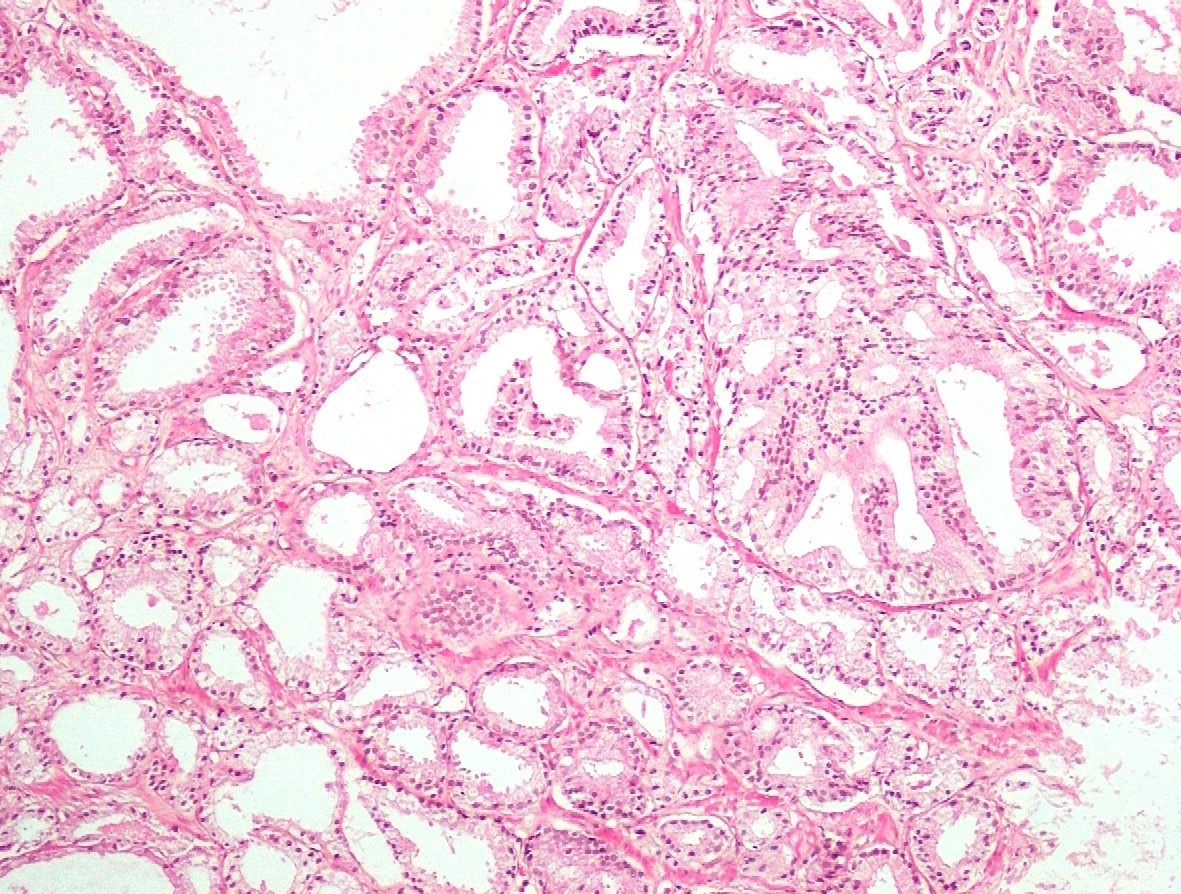 Figure 1. Prostatic adenocarcinoma grade group 2; Gleason score
3+4=7 (100X; H&E).
Figure 1. Prostatic adenocarcinoma grade group 2; Gleason score
3+4=7 (100X; H&E).
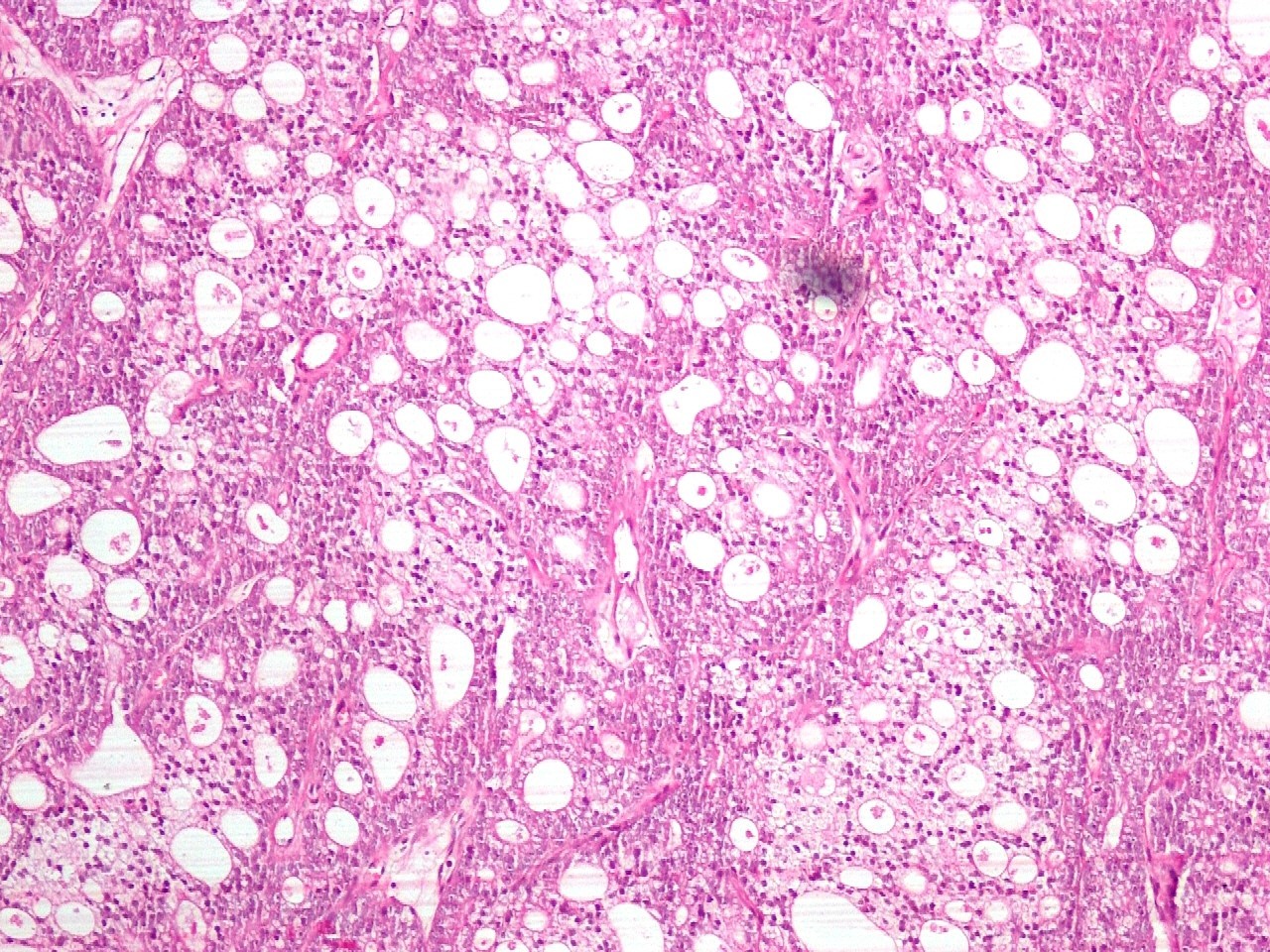 Figure 2. Glands in a diffuse pattern along with cribriform
glands grade group 5; Gleason score 5+4=9 prostatic adenocarcinoma (100X;
H&E).
Figure 2. Glands in a diffuse pattern along with cribriform
glands grade group 5; Gleason score 5+4=9 prostatic adenocarcinoma (100X;
H&E).
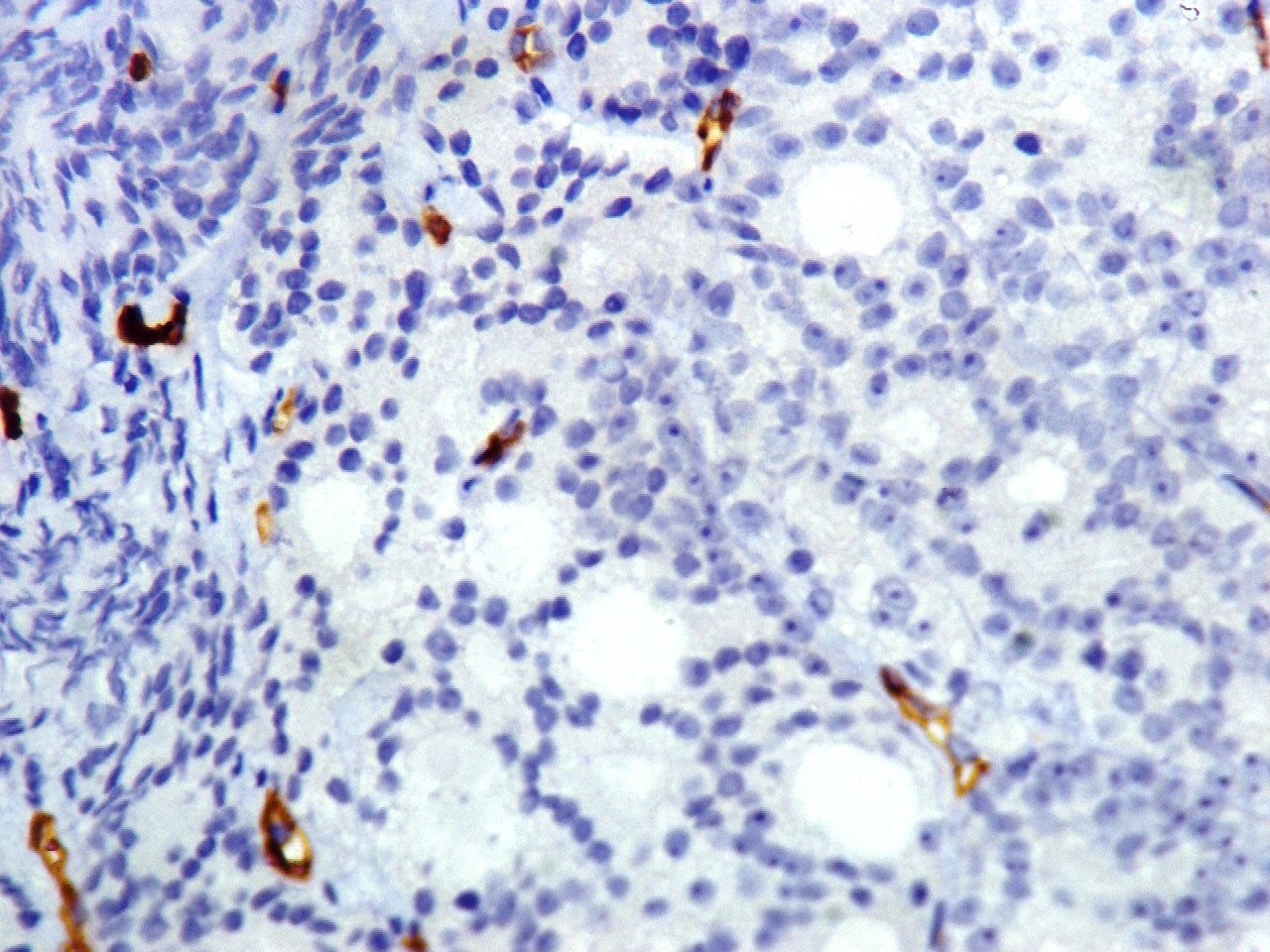 Figure 3. CD105 focus on hot spot areas around the cribriform
pattern (100X; IHC).
Figure 3. CD105 focus on hot spot areas around the cribriform
pattern (100X; IHC).
 Figure 4. CD105 stained
microvessels in hot spot areas in prostatic adenocarcinoma (400X; IHC).
Figure 4. CD105 stained
microvessels in hot spot areas in prostatic adenocarcinoma (400X; IHC).
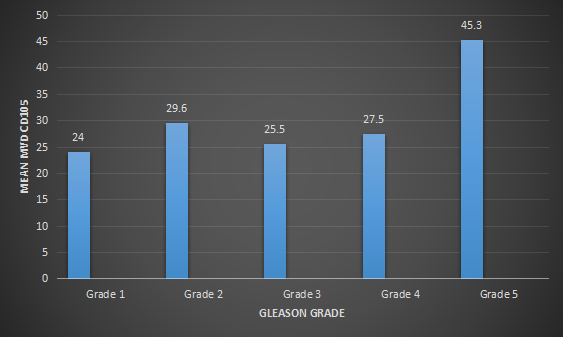 Figure 5. Correlation of
cases according to Gleason Grade group and MVD by CD105.
Figure 5. Correlation of
cases according to Gleason Grade group and MVD by CD105.
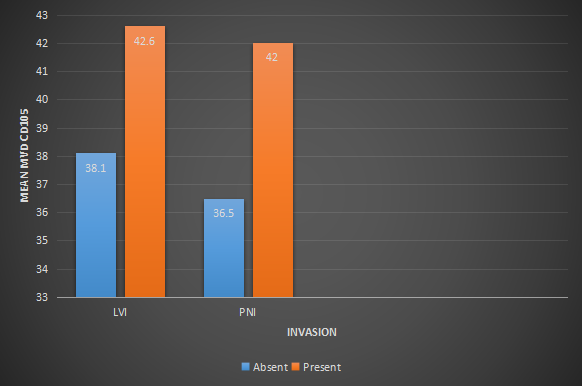 Figure
6. Correlation of cases according to LVI and PNI
status and MVD by CD105.
Figure
6. Correlation of cases according to LVI and PNI
status and MVD by CD105.
Prostate cancer has shown an increase in age adjusted incidence worldwide with nearly seventy-five per cent occurring at the age of 65 years and above [16]. In the present study, the maximum number of subjects were from the age group of 71-80 years (48.39%) followed by the age group 61-70 years (29.03%), Similar results were reported by Wikstroma et al., where the mean age was 72 years (range 53-90 years) however a lesser mean age (59.2±6.3 years) were reported by El-Gohary et al [17,18]. The higher mean age observed may be due to delays in check up and lack of awareness. In the present study, the most common Gleason grade group was 5 (18/31; 58.0%) followed by an equal number of cases (5/31; 16.13%) in grade groups 2 and 4. The results were comparable with the study by Wikstroma et al., where the maximum cases had Gleason grade 5 [17]. Vidal et al., in their study, showed an equal proportion of cases in grade group 1 (27/46) and grade group 4 and 5 (27/46)[19]. Whereas El-Gohary et al, Jain et al & Rathod et al reported Gleason scores 6 &7 to be more common pattern [18, 20, 21]. Although limited data is available regarding the change in grade over time, a few studies suggest group grade increases with time [17-21]. Endoglin (CD105) stains small immature vessels formed during tumorogenesis, therefore, can be used for measuring microvessel density (MVD) and as a marker for prostate cancer [7, 13]. In this study, the mean MVD CD105 scores among the study subjects were 39.03±15.45 with minimum and maximum of 16 and 90 respectively. It was found that the mean MVD CD105 score increases with an increase in Gleason grade i.e. maximum MVD CD105 score was found in Gleason grade 5 while minimum in grade 1 except in grade 2 where mean MVD CD105 score was found to be more compared to grade 3. Higher gleason grade is associated with a higher endovascular proliferation and CD105 is a proliferation and hypoxia-induced protein expressed in endothelial cells of new blood vessels of tumour cells, thus showing an increased expression with increased Gleason Grade [18, 19].The difference between groups 2 and 3 might be due to difference in subject distribution among various grade groups.There were only 2 cases in grade group 3 with MVD score of 25 and 26. In grade group 2, there were 5 cases with MVD scores of 22, 22, 24, 35 and 45. When mean MVD CD105 scores in different Gleason grades were compared, the difference was significant (p-value <0.05). The results were in congruence with the studies by Upadhyaya et al, Weidner et al, Miyata et al and El-Gohary et al [18, 22, 23]. In the present study, less number of cases showed LVI (19.4%) while PNI were present in approximately half of the cases which was comparable to the study by Patil et al [24]. Mean MVD CD105 was also slightly higher in subjects with the presence of LVI in comparison to those with the absence of LVI which is analogous to the study by El-Gohary et al and Mean MVD CD105 was slightly higher in subjects with the presence of PNI in comparison to the absence of PNI were in congruence with a study by Egemen Akıncıoğlu et al. However no statistically significant correlation was found between mean MVD and LVI or PNI [18, 25].
We thank the participants for their valuable contributions.
Ethical policy
Approval from the institutional ethical committee was taken.
Availability of data and materials
All data generated or analysed during this study are included in this publication.
Author contributions
SHA, MK: Conception; GS, SHA, MK: Performance of work; SHA, SEA, SK, SAA: Interpretation of data; SHA, GS, MK: Writing the article.
Competing interests
We have no disclosures that are related to the current study.
Funding
None.
- Siegel RL, Miller KD, Fuchs HE, Jemal A: Cancer statistics, 2022. CA Cancer J Clin 2022, 72(1): 7-33.
- Bray F, Ferlay J, Soerjomataram I, Siegel RL, Torre LA, Jemal A: Global cancer statistics 2018: GLOBOCAN estimates of incidence and mortality worldwide for 36 cancers in 185 countries. CA Cancer J Clin 2018, 68(6): 394-424.
- Ferlay J EM, Lam F, Colombet M, Mery L, Pineros M, Znaor A: Global cancer observatory: Cancer Today. Lyon, France: International Agency for Research on Cancer 2013, (5): 673-679.
- Chodak GW, Haudenschild C, Gittes RF and Folkman J: Angiogenic activity as a marker of neoplastic and preneoplastic lesions of the human bladder. Ann Surg 1980, 192(6): 762-771.
- Folkman J: What is the evidence that tumours are angiogenesis-dependent? J Natl Cancer Inst 1990, 82: 4-6.
- Dariš B, Munda M: Microvessel density and PSA level in prostatic adenocarcinoma of Gleason score 6 and 7. Acta Med Biotech 2018, 11: 50-56.
- Yashuyoshi Miyata, Yuji Sagara, S.i. Watanabe, A Asai, T Matsuo, K Ohba, H Sakai: CD105 is a more appropriate marker for evaluating angiogenesis in urothelial cancer of the upper urinary tract than CD31 or CD34. Virchows Archiv 2013, 463(5): 673-679.
- Beresford MJ, Harris AL, Ah-See M, Daley F, Padhani AR, Makris A: The relationship of the neo-angiogenic marker, endoglin, with response to neoadjuvant chemotherapy in breast cancer. Br J Cancer 2006, 95(12): 1683-1688.
- Fonsatti E, Jekunen AP, Kairemo KJ, Coral S, Snellman M, Nicotra MR, Natali PG, Altomonte M, Maio M: Endoglin is a suitable target for efficient imaging of solid tumours: in vivo evidence in a canine mammary carcinoma model. Clin Cancer Res 2000, 6(5): 2037-2043.
- Minhajat R, Mori D, Yamasaki F, Sugita Y, Satoh T, Tokunaga O: Organ-specific endoglin (CD105) expression in the angiogenesis of human cancers. Pathol Int 2006, 56(12): 717-723.
- Bodey B, Bodey Jr B, Siegel SE, Kaiser HE: Over-expression of endoglin (CD105): a marker of breast carcinoma-induced neo-vascularization. Anticancer Res 1998, 18(5A): 3621-3628.
- Fonsatti E, Sigalotti L, Arslan P, Altomonte M, Maio M: Emerging role of endoglin (CD105) as a marker of angiogenesis with clinical potential in human malignancies. Curr Cancer Drug Targets 2003, 3(6): 427-432.
- Kopczyńska E, Makarewicz R: Endoglin-a marker of vascular endothelial cell proliferation in cancer. Contemp Oncol (Pozn) 2012, 16(1): 68-71.
- Delahunt B, Miller RJ, Srigley JR, Evans AJ, Samaratunga H: Gleason grading: past, present and future. Histopathology 2012, 60(1): 75-86.
- Epstein JI, Egevad L, Amin MB, Delahunt B, Srigley JR, Humphrey PA: The 2014 International Society of Urological Pathology (ISUP) Consensus Conference on Gleason Grading of Prostatic Carcinoma: Definition of Grading Patterns and Proposal for a New Grading System. Am J Surg Pathol 2016, 40(2): 244-252.
- Sillman F, Boyce J, Fruchter R: The significance of atypical vessels and neovascularization in cervical neoplasia. Am J Obstet Gynecol 1981, 139(2): 154-159.
- Wikstrom P, Lissbrant IF, Stattin P, Egevad L, Bergh A: Endoglin (CD105) is expressed on immature blood vessels and is a marker for survival in prostate cancer. Prostate 2002, 51(4): 268-725.
- El-Gohary YM, Silverman JF, Olson PR, Liu YL, Cohen JK, Miller R, Saad RS: Endoglin (CD105) and vascular endothelial growth factor as prognostic markers in prostatic adenocarcinoma. Am J Clin Pathol 2007, 127(4): 572-579.
- Vidal AC, Duong F, Howard LE, Wiggins E, Freedland SJ, Bhowmick NA, Gong J: Soluble Endoglin (sCD105) as a Novel Biomarker for Detecting Aggressive Prostate Cancer. Anticancer Res 2020, 40(3): 1459-1462.
- Jain D, Gupta S, Marwah N, Kalra R, Gupta V, Gill M, Jain N, Lal S, Sen R: Evaluation of the role of alpha-methyl acyl-coenzyme A racemase/P504S and high molecular weight cytokeratin in diagnosing prostatic lesions. J Can Res Ther 2017, 13: 21-25.
- Rathod SG, Jaiswal DG, Bindu RS: Diagnostic utility of triple antibody (AMACR, HMWCK and P63) stain in prostate neoplasm. J Family Med Prim Care 2019, 8(8): 2651-2655.
- Upadhyaya, Agarwal, Karak, Sinha, Karki, Dhakal, Khadka: Microvessel density in Prostatic Lesions: Relevance to prognosis. J Pathol Nepal 2016(6): 898-901.
- Miyata Y, Sagara Y, Watanabe S, Asai A, Matsuo T, Ohba K, Hayashi T, Sakai H: CD105 is a more appropriate marker for evaluating angiogenesis in urothelial cancer of the upper urinary tract than CD31 or CD34. Virchows Arch 2013, 463(5): 673-679.
- Renuka P, Anuradha CK, Ksheera C, Prajakta RK: Significance of Prostate Carcinoma Grade Groups vis-à-vis Biochemical Recurrence. Nat J Lab Med 2021, 10: 50-52.
- Akıncıoğlu E, Seçinti İE, Kandemir O, Şerefoğlu EC: Prostat karsinomunda CD105 and C31. Acta Oncol Tur 2016, 49(1): 21-26.
Annals of urologic oncology
p-ISSN: 2617-7765, e-ISSN: 2617-7773
 Copyright © Ann Urol Oncol. This work is licensed under a Creative Commons Attribution-NonCommercial-No Derivatives 4.0 International (CC BY-NC-ND 4.0) License.
Copyright © Ann Urol Oncol. This work is licensed under a Creative Commons Attribution-NonCommercial-No Derivatives 4.0 International (CC BY-NC-ND 4.0) License.

 Submit Manuscript
Submit Manuscript